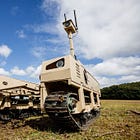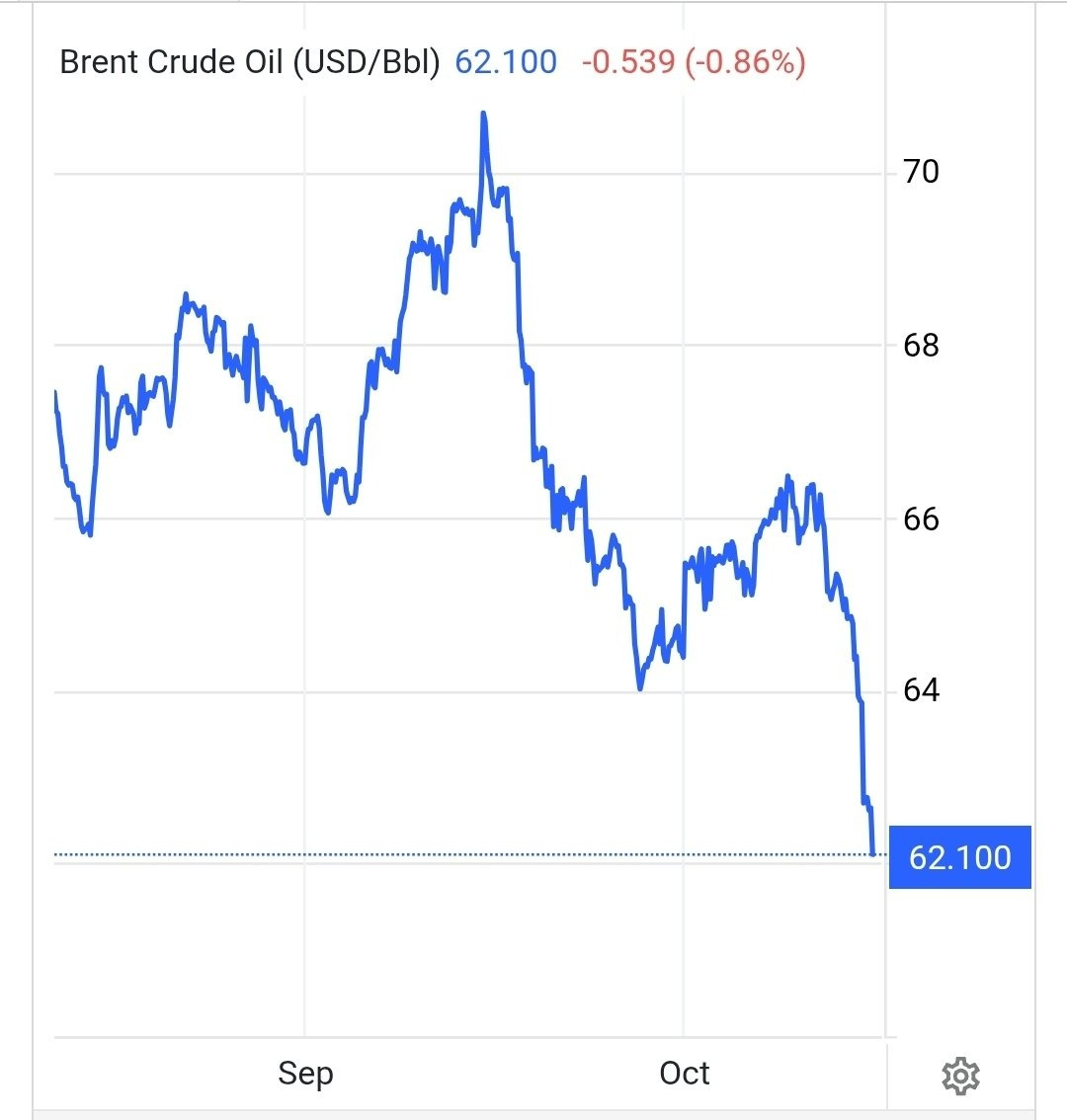Putin's War Has Destroyed Russia
It's all downhill from here

There is a point where propaganda cannot shape reality, where the Russian economy is projected to grow at just 0.9 percent in 2026, where inflation will rise while the economy stagnates, and the market knows it. Russian stocks suffered their worst losses in three years last week after the state started seizing publicly-owned companies and stiffing the shareholders, earning a rare rebuke from the central bank. Vladimir Putin bet on a short war in Ukraine followed by lingering sanctions in the West. Instead, he got a long, hideously expensive war awith ever-ratcheting sanctions pressure. The result is a collapsing civilian economy. Russia is its war economy, now.
Major Russian employers are laying off workers and operating with shortened work weeks to avoid layoffs. Cemros, once among the biggest players in European cement markets, has to furlough workers. Alrosa, a diamond mining company, is reducing payroll under severe inflation pressure. Mining company Mechel is cutting back coal production. Sveza, a huge lumber and wood products company, has received the Russian equivalent of a bank bailout after their CEO stepped down earlier this year to avoid falling out of a window.
And then there are the motor vehicle makers, the essential industry for modern transportation. The market for heavy trucks in Russia is down 57 percent from 2024, with KAMAZ being the biggest loser. Zombified foreign brands are getting favorable treatment from the Kremlin in order to maintain a facade of normality. But just look at the new Iskra in the screenshot above. Made from the cheapest parts with the fewest features possible, the Iskra is the perfect rally car for a ‘meat wave’ assault on a Ukrainian position, since it only needs to run 20 miles or so before it becomes a burned-out drone target.
A civilian owner on the other hand will likely have pieces falling off the car by 20,000 miles, assuming there is gasoline to actually put in the tank. That is no sure thing in Russia right now. A combination of international oil sanctions and kinetic Ukrainian oil sanctions has reportedly cut Russian fuels production by almost half, at this point. Estimates vary, but there are clear examples now of the fuel shortages across Russia and reaching the front. As one shiny panel after another breaks and slips and falls off Putin’s war machinery, revealing the jalopy underneath the Potemkin rally car, military collapse begins to seem more possible all the time, because it is.
During the last few weeks, I onboarded as a staff editor without a byline at Genspect and attended their conference. The increased workload and travel time means I will have slightly less attention to give this website, so I am lowering the price of premium subscriptions by $1 a month.

We are now in the fourth week of the Dobropillya cauldron north of Pokrovsk, where “thousands” of Russian soldiers were massed in hopes of achieving a decisive breakthrough in a new direction, only to get cut off and surrounded by Ukrainian defense forces, with no resupply except by air drone. Withdrawal was of course not an option. Instead, Russians have used their own offensive drones to interdict Ukrainian resupply and attack the Ukrainian rear. They mainly rely on fiber optic guided (FOG) drones, which have much higher kill rates than radio-controlled drones in an electronic warfare environment.
Three weeks ago, Russians already complained that there were as many as five Ukrainian drones for every Russian soldier. Videos posted to Telegram started showing Russian soldiers on bicycles and even attacking on horseback, with predictable results for the terrified animals. Russia’s army is decaying all the time. Ukrainian frontline logistics are as collapsed as Russia’s, but the Ukrainians are hardly ever attacking, and they are increasingly using unmanned ground vehicles (UGVs) to reduce the risks of resupply and casualty extraction.
There were three distinct pockets near Dobropillya three weeks ago. At that point, Ukrainians say they had captured more than 100 Russians, killed 1,322, and wounded another 1,134. Responsive to “urgent” commands from Moscow to take Pokrovsk, “the Russians are losing over 100 of their personnel per day, sometimes up to 200” Volodymyr Zelensky told reporters yesterday. The same basic conditions apply after three weeks: the battlefield does not look very different.
Altogether, Ukraine has inflicted 12,000 casualties on Russia in the Dobropillya area since 21 August, more than 7,200 of them “irrecoverable”, i.e. dead. “We believe this operation has disrupted the Russian summer offensive campaign” all the way into the fall. Officially delayed until November, it has effectively been canceled.
The War Zone talked to Lt. Col. Arsen “Lemko” Dmytryk, chief of staff to the First Azov Corps, which was brought into the Dobropillya area after the Russian offensive began on 3 August. Col. Dmytryk says there were 100,000 Russians in the area by the time he arrived on the scene. To coordinate the defense, “we built a joint command point. All the units that took part in this operation to stop the enemy assault joined that command point”, he explained.
Centralization of information among independent commands allowed “more than 100 commanders from our side” to stabilize the situation and turn it to Ukraine’s advantage. Now winter is coming, and with it, a reconnaissance advantage.
Look, soon there will be no leaves on the trees. They would all have fallen and without leaves, it’s almost impossible to use these small groups of enemies on foot because we will simply see them. But the enemy keeps learning. Every time the enemy uses new tactics.
Right now, “their tactic is that first they advance with a tank and this is a special tank. It has radio electronic warfare and some special anti-mine equipment.” Emphasis added:
After the tank, they have armored vehicles for infantrymen. Usually, before the tank, they can send several motorcycles to clear the road of mines. We call this a tank fist. So when this tank fist makes a hole in the Ukrainian defenses, Russian infantry use either motorcycles or light vehicles like buggies. [Edit: Or, Ladas.] Nowadays, this is the enemy’s most common assault tactic. But we should say the enemy uses the meat grinder still. Every single day, the Russian army loses hundreds of people by sending them either on foot or on motorcycles. This is the meat grinder.
A “tank fist” followed by light vehicles followed by Russian infantry on foot, horse, or bicycle, perhaps leading donkeys: this Mad Max Beyond Blunderdome parade marches into the “meat grinder” two by two, anymore, because larger groups draw cluster munitions that leave no survivors. On average, only one of every pair of infantry soldiers will reach the objective. By the time enough Russians have assembled in any one place to form a real infantry threat, the Ukrainians have usually found and targeted them with a drone.
Russians try to attack in the rain, for on a rainy day, “there are no drones in the sky. For either side”, so Ukraine uses UGVs to do “remote mining” of the approaches, Col. Dmytryk says. “And from our side, we always have two to three tanks that are always ready to start fighting” and take out a two-man ‘sabotage and reconnaissance’ team hiding in a building, for example.
In his area of responsibility, “from August 3, 5,000 Russian soldiers were killed. We do not count wounded now.” Col. Dmytryk estimates that 80 Russians have been captured. “We eliminated hundreds of their vehicles and different equipment, and they have thousands of wounded soldiers on their side” as well, Dmytryk says. Losses are almost always visually confirmed with drones.
Between drone video and GoPro-style cameras, this is the most-documented war in human history, by far. At this point, I have observed thousands of hours of combat video from Ukraine, giving me deeper insight into this conflict than any I have ever studied. A video compliation from the 414th UAV Brigade, the Birds of Magyar, shows the precision with which their operators enter the doorways of buildings, search under vehicles and overhangs, and fly through branches to find and eliminate personnel. The faces of several Russians are captured in their last moments.
According to a purported leaked Russian document that appeared this week, 86,744 Russians were killed in action during the first eight months of 2025, about 10,843 per month, with 281,550 total casualties. The demographic crisis of Putin’s war is not a future event, it is already happening, creating both a labor shortage and low productivity at the same time.
Alexandra Prokopenko writes at the Kyiv Post that “contract soldiers will have to be demobilized en masse and forced to retrain and integrate into the civilian economy” as a precondition for Russia returning to a peacetime economy. Rest assured, dear reader, that Putin does not want one million Russian men to ever come home again, armed and angry, in any case. They are dead men walking, to Putin.
“Yesterday you were a drunk, a loser, and a non-commissioned officer from the outskirts, and today you’re a cyberman in the Soviet Union and in the war of the future: the salt of the earth, so take a million rubles, too, since you’re such a good guy”, Yigal Levin writes in reacting to the new recruiting ads in Russia. “And if you don’t want to be a cyber-diver, then just guard a facility (the one in Pokrovsk or, well, in that forest) , and you’re still a good guy; here, grab the dough too.”
The ad for infantry targets “total losers, loan debtors, and all sorts of riffraff from the depths of the empire.” Tyumen Oblast, for instance: on the northern border of Khazakhstan, far across the Ural mountains from the Moscow-Saint Petersburg metropole, the enlistment bonuses are sky-high. But the picture is uneven, and as we have already analyzed, this form of recruiting tends to attract low-quality recruits that diminish further in quality over time. Russia is simply being ‘mined out’ of these men: an extraction economy.
Until last week, the largest share of those men were headed toward the Donbas. Five weeks ago, OSINT analysts were calling the Dobropillya salient “the largest regroupment of [Russian] forces” since the 2022 Battle of Kyiv. Four Russian Naval Infantry brigades were drawn into the cauldron over the ensuing three weeks. The Kremlin allocated significant resources to Pokrovsk, got stuck in a thornbrake, and only just figured out last week that Dobropillya is a disaster.
So they are doing what they have always done in this war: pick a new direction and try again. It is difficult to say just what is happening in the Zaporizhzhia ‘direction’, as Europeans are wont to say describing positional battles. According to Gen. Valery Gerasimov, who somehow still has his job running the Ministry of Defense, “the main goal of the new offensive is seizing Prymorske and Stepnohirsk in the Zaporizhzhia region, with fresh assaults planned in Dnipropetrovsk” (per NOEL Reports).
Between the Russian Telegrammers critical of wishcasting and the doomcasting of David Axe, there does appear to be a new Russian effort in this area far southwest of Pokrovsk. Whether it will significantly threaten Zaporizhzhia city before the usual fire brigades arrive to shut it down is another question. The fastest Russian advance in Ukraine is still a crawl.

Every Russian commander has their own fuel requirements to look after within their area of responsibility. Continuing strikes on storage facilities, for example in Crimea, reduce the fuel availability within the specific command zones being struck. As fuel becomes scarce, the potential for tension between commands will grow. While this situation is unlikely to descend into infighting by Russian commanders over the last dregs of gas, decisions inside the Russian Ministry of Defense are increasingly being shaped by fuel. There will be arguments about who gets what.
Personnel is policy. Russia’s second-highest ranking general, Andrey Nikolayevich Mordvichev, oversees operations in the Donbas under the direct supervision of Gen. Valery Gerasimov. Gen. Denis Igoryevich Lyamin recently took over the command area where Dnipropetrovsk lies after his predecessor was relieved.
Whereas the Donbas (“Center”) has gotten the lion’s share of resources until now, a new offensive in the Zaporizhzhia direction necessarily reallocates resources in that direction, to the new guy. Alternately, the new guy has laid up stores for an offensive while the Russian force in the Donbas is flagging. Either way, fuel is likely a significant factor in the decision to reallocate troop strength to the new sector. I will keep an eye out for evidence of this pattern.
Of course, even if Ukraine put all of Russia’s refining capacity out of service, Russia could still send oil to China and India and then import the gasoline and diesel they produce from it. This is a collapsing proposition in the long term, however, because Russia loses money in the transactions. Oil prices are currently quite low globally, making Russian discount oil less attractive. Russia stands to become its own best customer for its own petroleum exports, that way.
Much of the commentary on Russian fuel shortages has focused on the obvious effects to Russian logistics and assaults. I have yet to hear even an informed observer note that when diesel generators run dry, front line soldiers without access to an electrical grid will progressively lose their electronic warfare protection.
Never mind those huge, expensive systems that can jam satellites in low earth orbit. Ukraine is covered in drone protection systems. As the backpack drone jammers run out of juice, and Russians cannot find a recharge, and the vehicle-borne jammers cannot be turned on because the vehicles are out of gas, and there are no fresh batteries arriving by any means, Ukrainian FPV operators will have a glorious time.
The complexity of the emerging battlefield can be the undoing of Russian arms. However, it is nto clear that the Kremlin worries about this very much. Vladimir Putin does not really care about Pokrovsk in particular so much as war in general, at this point. He has already destroyed the Russia that existed in 2022. The Russia that exists in 2026 will not be as capable of industry or technical adaptation. Putin knows this. He has made preparations.
Having passed up the last, best hope for a peaceful negotiation with Trump, the Kremlin has increased military posturing towards the West with ‘hybrid war’, drones and airport shutdowns, and brave talk of preparations for war with NATO. For like the proverbial shark that cannot stop swimming or it will die, the Russian war economy must continue so that Putinism survives. This creates new vulnerabilities and risks of systemic failure and collapse.
No railways, no Russia. In desperation to keep their trains running on time, the Russian state railroad company has been “expediting delivery” by turning off safety systems on the Warsaw-Saint Petersburg line. A month ago, this led to disaster when an electrical train going nearly twice the speed limit derailed, killing the engineer. “The TSKBM safety system was not engaged, and the KLUB-U block was set to track ‘0’—this ‘trick’ allows for speeds of up to 200 km/h”, explains the Cheka-OGPU channel.
The railroad blamed Ukrainian sabotage. Railroad officials consider themselves untouchable, but who knows, in this economy? “The engineer’s qualifications suggest that the train was being driven by someone well-versed in bypassing safety interlocks to operate the locomotive without the automatic speed limiter.” As I have explained in recent historical essays here, the wartime history of Russian railroads is replete with corner-cutting, unsafe operations, and accidents.
The cause of the monstrous speed increase was the dispatch of faulty electric train No. 839 (on the St. Petersburg-Pechory-Pskovskie route), which required a backup locomotive. It was to rescue it that the TEP70BS was deployed — at the cost of the engineer’s life and extensive damage.
As I have also explained in a series of recent posts here, Ukraine has simultaneously made consistent efforts to attack Russian rail logistics wherever possible. It is my understanding at the time of this writing that the wreckage of a Russian fuel train recently destroyed on the ‘land bridge’ route to Crimea is still sitting on the single-line track, waiting to be cleared. As the stretch of track lies well within small drone range of Ukrainian lines, Russians appear to have abandoned the route altogether.
Russians have responded to the Ukrainian campaign with a flurry of hundreds of strikes on trains, including passenger trains and stations. The Ukrainian railway company somehow manages to keep the trains running on time, anyway. Meanwhile, Ukraine is becoming the excuse for very Soviet-style system failures. The destroyed Russia is in fact the ‘new Russia’ of booming oil wealth that Putin had in 2022.
We are back to the old Russia, the one where lies are enforced: You love your shitty Lada. You love waiting in line for gas. You love hearing the drones buzz overhead, — because you love Russia. Don’t you love Russia? Say you love Russia, and sound like you mean it.
Sign the contract and the pain will be over. Your family will dine out on your memory for a year. Never mind the overheated economy or the empty grocery shelves. This is how Russia works now, has always worked, will always continue to work.
Distrusting Z-Patriots, Putin Is Replacing Russian Volunteerism With Terror
The special military operation was supposed to be short and victorious. It has been neither, and now civilian volunteer support is collapsing. “Donations are very scarce, people are fed up,” Elena, a volunteer fundraiser in Kursk Oblast, tells The Insider





